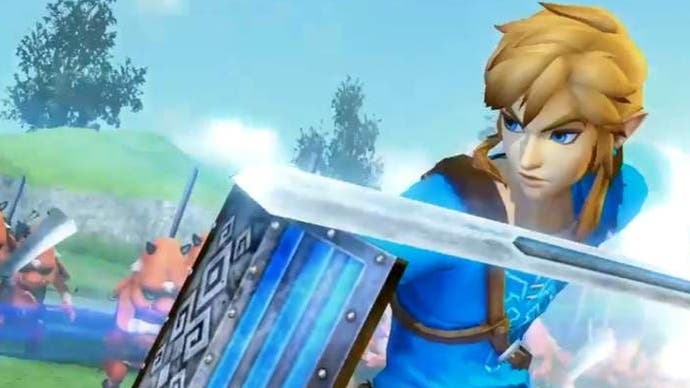Hyrule Warriors' decent Switch port is marred by weird tech decisions
1080p resolution in mobile mode cripples frame-rate.
The deluge of Wii U ports for Switch continues and the recent arrival of Hyrule Warriors: Definitive Edition offers up a great opportunity to improve a game that was somewhat disappointing - in performance, at least - on the older system. The good news then: developer Omega Force's efforts on Switch satisfy on several key fronts, and it's easily the most feature-complete version of the game. However we're still one patch away from perfection, since this new release is marred by some highly questionable tech decisions - most curious of all being that Switch's mobile mode downsamples from 1080p, with a disastrous impact to performance.
But let's rewind and look at the game more generally. Hyrule Warriors is another in a long line of 'musou' titles inspired by Dynasty Warriors - action fighting games defined by the concept of pitting the player character against a legion of cannon-fodder opponents. The PlayStation 2 series entries all ran at a beautiful 60 frames per second, but with the migration of the concept onto Xbox 360 and PlayStation 3, Koei experimented with dropping frame-rate to 30fps on certain games, while others still targeted the full 60. It's a level of experimentation that has seen performance generally move in the wrong direction for the 'Warriors' games, culminating in the unfortunate release of Dynasty Warrior 9, one of the worst performing titles of the current-gen era.
Released towards the end of 2014, Hyrule Warriors on Wii U was another game that fell short in the performance stakes, struggling to maintain its target 30 frames per second, and actually running more slowly than the (admittedly less complex) New 3DS version. Switch was a chance to put things right, and to give the developer its due here, playing when docked offers huge frame-rate and resolution advantages. Wii U's native 720p gives way to full 1080p on Switch, while the tepid sub-30fps performance level is now unlocked, scaling from anywhere between 35fps and 60fps. It's not ideal, but even if it is wavering under that target 60Hz refresh, the upgrade over Wii U is clear. Put in context with a like-for-like combat scene, we noted a 19fps advantage in favour of Switch.
There's more too - while it's difficult to get exact, matching head-to-head comparisons between Wii U and Switch, there is evidence of improved enemy counts, with more characters rendered towards the distance than before. Also to its benefit is a visible upgrade in alpha effects too, notably the fire transparency in the first Volga boss battle - plus a few cases of improved texture-work. Otherwise though, it's business as usual with largely similar assets and character model detail, plus a similar omission of anti-aliasing to the Wii U original. The bottom line is clear then - Hyrule Warriors: Definitive Edition is an improvement over the original, but questionable technical decisions marr the overall experience.
As mentioned earlier, playing Switch as a pure handheld still renders the game at the same 1080p pixel count as the docked experience - despite it only having a 720p window to view it. On the plus side, you do get pristine image quality thanks to a 2.25x supersampling effect from 1080p down to 720p - and it's easy to catch too, given there's no anti-aliasing whatsoever in Swith's docked mode anyway. However, the downclocked GPU struggles with that load, and performance drops to around 30fps - and potentially under. The hit to performance is plain to see even on the smaller screen, and for portable play, it's baffling why Switch's resolution doesn't change to a more logical native 720p.
We've seen something like this before when we checked out Payday 2 - but that game only stayed at native res when undocking. If you booted the game from scratch, you got native 720p on the go - indicating a bug in the undocking code. For Hyrule Warriors though, it's 1080p whether you undock or whether you boot afresh in mobile mode. With performance the only real problem with the portable experience, we'd hope that Koei returns to the game and sets the untethered mode to native 720p - problem solved.
The second issue is that the docked mode's 1080p resolution is clearly too much for the Switch to handle, meaning that users get a highly variable performance level, stuttering more heavily when the GPU is taxed with challenging effects work or the series' signature packed battlefield. Was 1080p the right choice here for an action game like this, when 900p or lower could have taken the game closer to its target 60fps? Better yet, why not adopt the approach seen in Fire Emblem Warriors, which offered users the opportunity to run at a lower resolution with a much closer lock to 60fps, or go for a straight 1080p30 instead, according to taste?
As things stand, the quality of this Switch Hyrule Warriors port is such that it's undoubtedly the best version of the game available. It packs in all the stages, characters and DLC of the other versions - but the bizarre technical choices on mobile mode, combined with a regression in options compared to Fire Emblem Warriors, means that this isn't quite the definitive edition we might have hoped for. Koei has all of the individual components at its fingertips to deliver a great experience - and we get the sense it's one update away from everything coming together. Bearing in mind some of the negative feedback surrounding the release - particularly in terms of its mobile performance - we hope that the developer returns to the game and introduces the necessary fixes.










